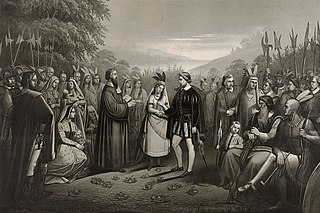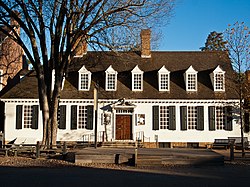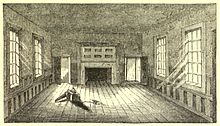
Peyton Randolph was an American politician and planter who was a Founding Father of the United States. Born into Virginia's wealthiest and most powerful family, Randolph served as speaker of Virginia's House of Burgesses, president of the first two Virginia Conventions, and president of the First Continental Congress. He also served briefly as president of the Second Continental Congress.

John Murray, 4th Earl of Dunmore was a Scottish peer, military officer, and colonial administrator in the Thirteen Colonies and The Bahamas. He was the last royal governor of Virginia. Dunmore was named governor of New York in 1770. He succeeded to the same position in the colony of Virginia the following year after the death of Norborne Berkeley, 4th Baron Botetourt. As Virginia's governor, Dunmore directed a series of campaigns against the trans-Appalachian Indians, known as Lord Dunmore's War. He is noted for issuing a 1775 document, Dunmore's Proclamation, offering freedom to slaves who fought for the British Crown against Patriot rebels in Virginia. Dunmore fled to New York after the burning of Norfolk in 1776 and later returned to Britain. He was Governor of the Bahamas from 1787 to 1796.
William Johnston Dawson was a U.S. Congressman from the state of North Carolina from 1793 to 1795 and a member of the North Carolina House of Commons.
Carter Bassett Harrison was a politician from the U.S. state of Virginia.

The Wren Building is the oldest building on the campus of the College of William & Mary in Williamsburg, Virginia. Along with the Brafferton and President's House, these buildings form the College's "Ancient Campus." With a construction history dating to 1695, it is the oldest academic building still standing in the United States and among the oldest buildings in Virginia. It was designated a National Historic Landmark in 1960.

The Governor's Palace in Williamsburg, Virginia, was the official residence of the royal governors of the Colony of Virginia. It was also a home for two of Virginia's post-colonial governors, Patrick Henry and Thomas Jefferson, until the capital was moved to Richmond in 1780, and with it the governor's residence. The main house burned down in 1781, though the outbuildings survived for some time after.

The Capitol at Williamsburg, Virginia housed both Houses of the Virginia General Assembly, the Council of State and the House of Burgesses of the Colony of Virginia from 1705, when the capital was relocated there from Jamestown, until 1780, when the capital was relocated to Richmond. Two capitol buildings served the colony on the same site: the first from 1705 until its destruction by fire in 1747; the second from 1753 to 1780.
John Holloway was a politician and lawyer in the British colony of Virginia. He served as Speaker of the House of Burgesses (1720–34), having represented at various times, King and Queen County, York County and Williamsburg. He also served as the first mayor of Williamsburg, Virginia (1722–23), and treasurer of the colony (1723–34).
John Amson was an English physician and amateur botanist who moved to Virginia and served as alderman and mayor of Williamsburg, during the Colonial period, from 1750 to 1751.

Benjamin Waller was an American planter, lawyer, politician, military officer and judge.
John Stith was a member of the Virginia House of Burgesses and the progenitor of the Stith family, one of the first families of Virginia.
William Stith was an early American historian and an Anglican minister. He was the third president of the College of William & Mary (1752–1755), where Stith Hall was named for him.
William Dawson (1704–1752) was an Anglican clergyman, poet and member of the Governor's Council of Virginia who became the second president of The College of William & Mary in Williamsburg, Virginia (1743-1752).

John Tyler Sr. was an American lawyer, planter, politician and judge who served in the Virginia House of Delegates and became 15th Governor of Virginia and later United States district judge of the United States District Court for the District of Virginia. He was the father of U.S. President John Tyler.

The Virginia Association was a series of non-importation agreements adopted by Virginians in 1769 as a way of speeding economic recovery and opposing the Townshend Acts. Initiated by George Washington, drafted by George Mason, and passed by the Virginia House of Burgesses in May 1769, the Virginia Association was a way for Virginians to stand united against continued British taxation and trade control. The Virginia Association served as the framework and precursor to the larger and more powerful 1774 Continental Association.

The history of Virginia in the American Revolution begins with the role the Colony of Virginia played in early dissent against the British government and culminates with the defeat of General Cornwallis by the allied forces at the Siege of Yorktown in 1781, an event that signaled the effective military end to the conflict. Numerous Virginians played key roles in the Revolution, including George Washington, Patrick Henry, and Thomas Jefferson.

Reverend Richard Buck was a minister to the Colony of Virginia at Jamestown, Virginia from 1610 to 1624. He was chaplain of the first session of the Virginia General Assembly, which was composed of the House of Burgesses and the Virginia Governor's Council. This assembly met in the church at Jamestown on July 30, 1619, as the first elected assembly and law making body in colonial America.
John Blair was a merchant and politician of the colony of Virginia. He served in both houses of the Virginia General Assembly. As a member of the House of Burgesses, he initially represented Jamestown then Williamsburg, before being appointed to the Governor's Council. There he served for more than 25 years, including four times becoming acting governor during changes of the royal governors and while governor Francis Fauquier was in the New York and Georgia colonies. Nonetheless, this John Blair, the earliest of the four men of the name serving in the Virginia General Assembly, may be best known either as the nephew and heir of Rev. James Blair or father of John Blair, Jr..

Ewell Hall is an academic building on the campus of the College of William & Mary in Williamsburg, Virginia. The building was constructed in 1925–1926 on what is now Old Campus, across from Tucker Hall on the Sunken Garden. It was originally named Phi Beta Kappa Memorial Hall for Phi Beta Kappa, an honor society founded at the College of William & Mary and the oldest such society in the United States. John D. Rockefeller Jr. attended the hall's 1926 dedication; during this visit, W. A. R. Goodwin convinced Rockefeller to participate in a restoration program that became Colonial Williamsburg.

The Ludwell–Paradise House, often also called the Paradise House, is a historic home along Duke of Gloucester Street and part of Colonial Williamsburg in Williamsburg, Virginia. The home was built in 1752–1753 for Philip Ludwell III. In December 1926, it became the first property John D. Rockefeller Jr. authorized W. A. R. Goodwin to purchase as part of the Colonial Williamsburg restoration campaign. After being restored, the Ludwell–Paradise House held the Abby Aldrich Rockefeller Folk Art Collection from 1935 to 1956. The building now serves as a rented private residence in the Williamsburg historic area.

















